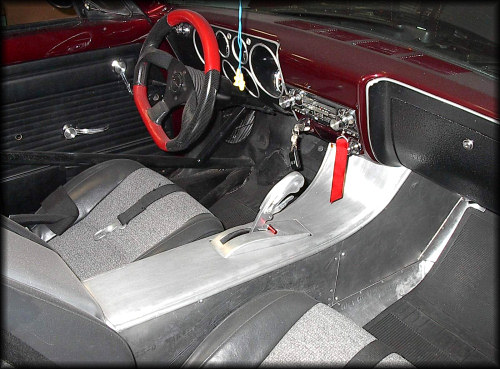

![]()
A stroked 383 cubic-inch Corv-8 Monza Roadster
|
Most people who decide to build a Crown-style V-8 conversion wonder how much torque and horsepower they can get away with. Archibald's experience allows him to offer enthusiasts good advice. "Ted Trevor built the first V-8 Corvair in 1967," he remembers, "and started offering kits shortly thereafter, which is much earlier than the early '70s, as some people believe. The big block Ted used was a 465 cubic-inch Can-Am engine. Ted said he got his hands on only one and did not elaborate on how. The car was breaking 10 seconds in the quarter-mile and the transaxle every time it ran." "What allows the 383 roadster to survive is the adaptation of a full size Powerglide transmission," he advises. "This is because the fluid coupling virtually eliminates the shock of the initial thrust load on the ring and pinion," he adds, referring to Mike Levine of Atlanta, Georgia, who successfully drag races a Crown Corvair using the 383/Powerglide combination and consistently running elapsed times in the 11:40s. |
|
Having at one time witnessed the horrors of a car's hood popping off at speed, Archibald opted to equip the 383 roadster with hood pins. Fastened by a loop retainer, they are the through-the-hood type so popular on the high performance cars of the 1960s. However, on the 383 roadster they are inverted with access to the loop retainer provided next to the headlight in the upper portion of the bucket assembly. They are invisible from the outside, yet fully functional. |
 |
|
The roadster's cockpit uses re-upholstered Toyota GT3 seats equipped with Simpson 5-point harnesses. The steering wheel is a Grant Corsa. Auto Meter gauges are mounted in a stock Corvair Corsa dash panel, providing critical information on vehicle speed, engine rpm, fuel level, oil pressure, oil temp, and system voltage. A separate transmission temperature gauge is mounted in a single gauge panel replacing the heater control panel. The shifter is a B&M reverse cable drag racing unit with a custom grip made by Archibald and his colleague in Corvair hot-rodding, Ralph Gonzalez. A shift light is hidden behind the steering wheel. |
 |
|
Don't do it! Archibald says the removable top was an engineering nightmare. It uses full glass, not acrylic. The side panels are flat with the frame making up for the curvature of the original glass. It is attached at the windshield using a header bow from a convertible welded to the same roof that was cut from the car, and factory convertible latch mechanisms. Mounted in the rear pillar area is a cam-lobe which captures a pin welded into the inner body structure. |
|
|
In the picture below we see what the roadster looks like with its removable hardtop in place. It works, but Archibald vows he will never again—in his entire life—take the roof off another coupe...until the next time. |
|
|
|
Chevy fans are quick to recognize the hot-rod Corvair's wheels as Z-28 rims from the 2nd generation (1970-81) Camaro. The tires are T/A radials; 225/50/15 at the front and 245/50/15 at the rear. Happily, it was not necessary to modify the car's inner and outer fender wells to accommodate these sizes. |
Click the road sign for more.
Select from the navigation bar!